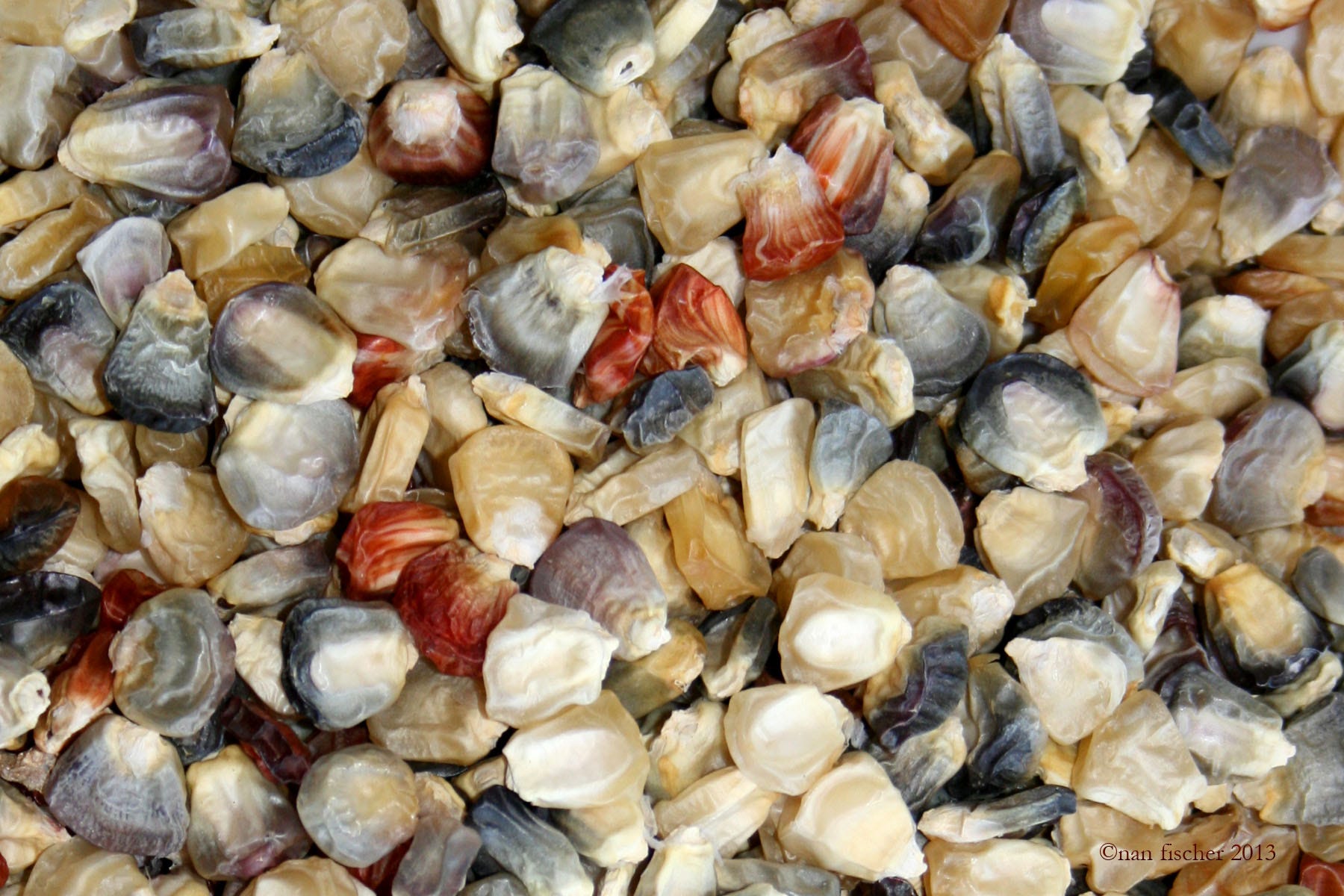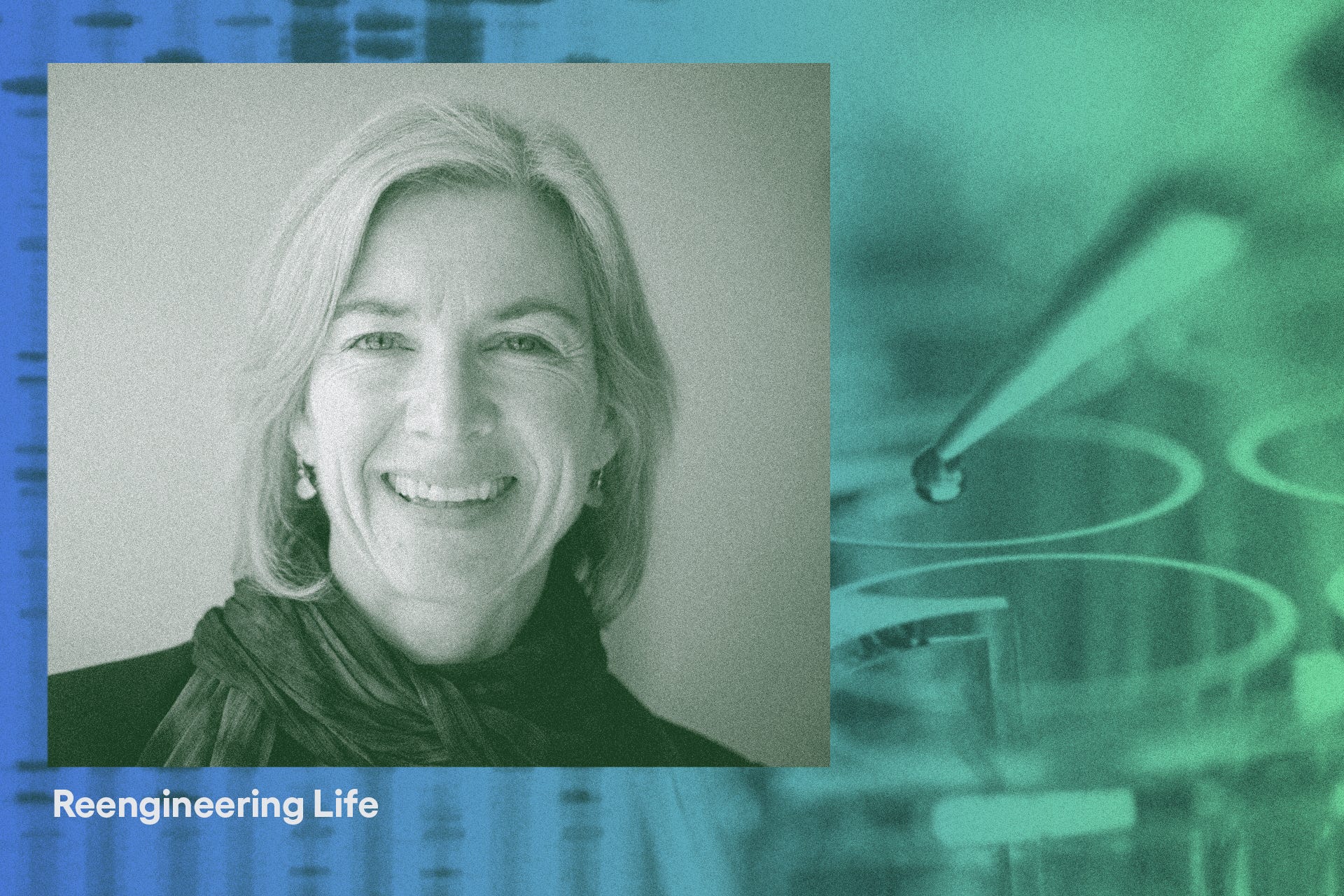Corn was domesticated nearly 9,000 years ago and has a rich history throughout the Americas.
nan fischer
Sep 7, 2018 ·

Painted Mountain Corn, photo ©Boxcar Farm, Llano, NM
Corn is one of America’s favorite vegetables in the garden and on the plate. From the rainbow-colored ‘Glass Gem’ flint corn to the classic ‘Golden Bantam’ sweet corn, corn is grown in many backyards. Buttery corn on the cob is part of almost every child’s summer memories. Popcorn and movies are inseparable. Corn chowder with oyster crackers warms us in winter. Cornbread, succotash, and taco shells are a few other common ways we heartily consume corn.
Corn (Zea mays subsp. mays) is known as “maize” in Mesoamerica and many places outside the U.S. and has its origins in a wild grass from Mexico called “teosinte.” Only five genes keep teosinte and corn from being genetically identical, and teosinte is the closest relative of today’s corn. All research and hypotheses point to the domestication of one of the four species of teosinte, Zea mays spp. parviglumis, about 9,000 years ago in Oaxaca by the Mayan people. Teosinte still grows wild in Mexico and is considered a weed and a nuisance to maize farmers. Its seed heads shatter and fall to the ground, making them hard to collect. Almost unrecognizable as a relative of today’s corn, teosinte has a branching growth habit and tiny heads of less than 12 kernels, each with a hard shell around it.
It’s hard to understand why this almost inedible plant was chosen to be cultivated as food. It may have been that there were anomalies which showed potential for food, more closely resembling today’s corn. Or maybe the environmental conditions thousands of years ago were so different they produced a teosinte other than what we see today.
No matter how domestication began, over thousands of years, the indigenous people of Mesoamerica bred a vast genetic diversity into maize that most crops never undergo. Maize was invented. Without human intervention, it would not be what it is today, and it would not continue to survive. Those ancient farmers were brilliant geneticists!
Maize’s Cultural Relevance
Besides being a revered food crop, maize was an integral part of Mesoamerican culture and spirituality. The “grain of the gods” ranked almost as high as royalty, and rituals, dances, and festivals celebrated its planting and harvest. Maize was depicted in hieroglyphics, petroglyphs, and artwork. The Mayans believed they were created from maize, and according to Charles Mann in his book 1491, Oaxacans still call themselves hombres de maiz, or men of maize.
Mesoamerican farmers noticed that teosinte grew with squash and beans in the wild, so they imitated that growing pattern in their milpas (crop-growing systems), and added other native crops, such as peppers, tomatoes, avocados, jicama, and amaranth. The plants benefited from the biological diversity, and the crops were nutritionally complementary, providing fat, protein, carbohydrates, and vitamins. Maize and the concept of the milpa migrated around Mesoamerica, eventually south to Peru and Chile and north into the future United States. Dozens of landraces were created as farmers adapted maize to their unique growing environments. The colorful palette of reds, blues, yellows, black, greens, and pinks represented the various growing conditions and the farmers’ preferences. According to Gary Paul Nabhan in Where Our Food Comes From, landraces reflected the different languages and cultures of each region because they were grown for specific purposes, such as tortillas, popcorn, textiles, and beer. This is true genetic diversity.
Large trading centers along busy routes saw the exchange of maize, stone, metal, feathers, shells, pottery, textiles, and culture. Maize arrived in the arid Desert Southwest nearly 4,000 years ago. About this time, ancestors of the Hohokam in the Sonoran Desert built an elaborate system of irrigation canals for farming. Farther north, the Anasazi in the Four Corners region and the Pueblo people of northern New Mexico also benefited from trade with Mesoamerica.
From the Southwest, trade routes radiated out to the West Coast and across the Great Plains. The indigenous people of the Plains traded with tribes near the Great Lakes. The idea of the milpa died out as it moved north because temperatures were too cold to grow some of the crops, such as avocados. But maize, which is very adaptable, was still being bred for local conditions and grown together with squash and beans, known collectively as Three Sisters.
By 900 A.D., maize was established along the Eastern Seaboard and in the Southeast. As a reliable crop for people and livestock, it had become a staple throughout the Americas. Maize has been credited for the rise of civilization because it’s adaptable, nutritious, and easy to dry and store for lean times.
Corn is one of America’s favorite vegetables in the garden and on the plate. From the rainbow-colored ‘Glass Gem’ flint corn to the classic ‘Golden Bantam’ sweet corn, corn is grown in many backyards. Buttery corn on the cob is part of almost every child’s summer memories. Popcorn and movies are inseparable. Corn chowder with oyster crackers warms us in winter. Cornbread, succotash, and taco shells are a few other common ways we heartily consume corn.
Corn (Zea mays subsp. mays) is known as “maize” in Mesoamerica and many places outside the U.S. and has its origins in a wild grass from Mexico called “teosinte.” Only five genes keep teosinte and corn from being genetically identical, and teosinte is the closest relative of today’s corn. All research and hypotheses point to the domestication of one of the four species of teosinte, Zea mays spp. parviglumis, about 9,000 years ago in Oaxaca by the Mayan people. Teosinte still grows wild in Mexico and is considered a weed and a nuisance to maize farmers. Its seed heads shatter and fall to the ground, making them hard to collect. Almost unrecognizable as a relative of today’s corn, teosinte has a branching growth habit and tiny heads of less than 12 kernels, each with a hard shell around it.
It’s hard to understand why this almost inedible plant was chosen to be cultivated as food. It may have been that there were anomalies which showed potential for food, more closely resembling today’s corn. Or maybe the environmental conditions thousands of years ago were so different they produced a teosinte other than what we see today.
No matter how domestication began, over thousands of years, the indigenous people of Mesoamerica bred a vast genetic diversity into maize that most crops never undergo. Maize was invented. Without human intervention, it would not be what it is today, and it would not continue to survive. Those ancient farmers were brilliant geneticists!
Maize’s Cultural Relevance
Besides being a revered food crop, maize was an integral part of Mesoamerican culture and spirituality. The “grain of the gods” ranked almost as high as royalty, and rituals, dances, and festivals celebrated its planting and harvest. Maize was depicted in hieroglyphics, petroglyphs, and artwork. The Mayans believed they were created from maize, and according to Charles Mann in his book 1491, Oaxacans still call themselves hombres de maiz, or men of maize.
Mesoamerican farmers noticed that teosinte grew with squash and beans in the wild, so they imitated that growing pattern in their milpas (crop-growing systems), and added other native crops, such as peppers, tomatoes, avocados, jicama, and amaranth. The plants benefited from the biological diversity, and the crops were nutritionally complementary, providing fat, protein, carbohydrates, and vitamins. Maize and the concept of the milpa migrated around Mesoamerica, eventually south to Peru and Chile and north into the future United States. Dozens of landraces were created as farmers adapted maize to their unique growing environments. The colorful palette of reds, blues, yellows, black, greens, and pinks represented the various growing conditions and the farmers’ preferences. According to Gary Paul Nabhan in Where Our Food Comes From, landraces reflected the different languages and cultures of each region because they were grown for specific purposes, such as tortillas, popcorn, textiles, and beer. This is true genetic diversity.
Large trading centers along busy routes saw the exchange of maize, stone, metal, feathers, shells, pottery, textiles, and culture. Maize arrived in the arid Desert Southwest nearly 4,000 years ago. About this time, ancestors of the Hohokam in the Sonoran Desert built an elaborate system of irrigation canals for farming. Farther north, the Anasazi in the Four Corners region and the Pueblo people of northern New Mexico also benefited from trade with Mesoamerica.
From the Southwest, trade routes radiated out to the West Coast and across the Great Plains. The indigenous people of the Plains traded with tribes near the Great Lakes. The idea of the milpa died out as it moved north because temperatures were too cold to grow some of the crops, such as avocados. But maize, which is very adaptable, was still being bred for local conditions and grown together with squash and beans, known collectively as Three Sisters.
By 900 A.D., maize was established along the Eastern Seaboard and in the Southeast. As a reliable crop for people and livestock, it had become a staple throughout the Americas. Maize has been credited for the rise of civilization because it’s adaptable, nutritious, and easy to dry and store for lean times.
Different Ways to Eat Maize
Early native cultures would harvest baby ears for the Green Corn Ceremony, held to celebrate a good growing season. It was also a purging and time of rebirth, akin to starting a new year. Green corn was a sweet treat, but it was never harvested in great numbers because the ears needed to mature to provide abundant food for the upcoming months.
Mature ears were boiled or roasted whole. Kernels cut from the cob were roasted, boiled, baked, fried, and cooked with other vegetables. Succotash, for example, is an indigenous meal of maize and beans that was cooked with bear grease or maple syrup.
As a grain, maize was ground into masa for tortillas and tamales. The addition of lime or wood ash released niacin and calcium to make it more digestible and nutritious. Fermented masa was made into an alcoholic beverage.
Native people often used all parts of the plant. Husks were woven into mats, baskets, dolls, clothing, and masks. Cobs were dried and used for rattles and fuel for the fire. Tassels were boiled into a sweet drink, and the stalks of some cultivars were eaten like sugarcane. Even corn smut, a common fungus, was eaten and is considered a delicacy today.
Maize Goes Global
Maize was foreign to the explorers from Spain and England. Columbus saw it for the first time when he arrived in Haiti. When the British landed on the eastern coast of the North American continent, they found maize fields that stretched for miles. They didn’t have a name for it, so they called it “corne,” which was a broad Middle English term for grain.
The British imported their staples of wheat, barley, oats, and rye, but these crops did poorly in their new environment. Some settlements were almost wiped out by starvation. The survivors realized they needed to grow what had proven to sustain an entire continent — maize.
The native people taught the Europeans how to grow and cook maize. Their farms soon provided enough to eat fresh, put away for winter, trade for other goods, and ship back to Europe, where farmers adapted the crop to local growing conditions.
After being brought to Europe, corn spread east and south from there and became a major staple in Africa, Eastern Europe, and China. Being adaptable, it grew where wheat or rice couldn’t and provided high energy and calories with its carbohydrates, fat, and sugar. Again, maize was responsible for burgeoning populations wherever it was introduced.
Old-Time Corn Cultivars
‘Golden Bantam’ corn was grown by William Chambers, a Massachusetts farmer in the 19th century, and was selected to be early and sweet. As the story goes, Chambers would gleefully share his harvest with his neighbors, whose crops weren’t nearly ready, but he wouldn’t share his seed. Burpee picked up the seeds after his death in 1891, developed the cultivar, and offered it for sale in 1902.
Growers today continue to improve corn strains out of curiosity, but also out of necessity. Dave Christensen of Montana has been breeding corn for more than 40 years. He gathered up dozens of rare strains that were grown throughout the Rocky Mountains and northern plains hundreds of years ago. He repeatedly selected seed from the hardiest plants that thrived in his harsh conditions and short season. ‘Painted Mountain’ corn is the result, and it’s surely on its way to becoming an heirloom.
Carl “White Eagle” Barnes developed ‘Glass Gem’ corn by isolating strains from his Cherokee ancestors. Over several years, he saved seed from the most colorful cobs. His selecting produced a wide variety of colors, each with a name, but ‘Glass Gem’ has become the best known and is grown to be popped, parched, and ground into meal.
Of course, ancient maizes are still being grown. Some are available commercially, but many others can only be found on the farms of indigenous people. ‘Hopi’ corn comes in a wide variety of colors and uses. ‘Oaxacan Green,’ ‘Mandan Bride,’ ‘Cherokee White Flour,’ and dozens more are still used for roasting and parching and to make flour, sweet corn, and popcorn.

Inca Rainbow Sweet Corn, photo ©nan fischer 2013
Preserving Heirloom Corn
Native and heirloom strains are disappearing as modern breeders try to “improve” them. We can keep the old cultivars alive by growing them, saving and sharing seed, and cultivating locally adapted landraces. It took 9,000 years for maize to become what it is today. We need to respect that work and the genetic diversity by protecting the old strains.
Whatever your favorite heirloom corn, you can be sure it originated in Mexico as agriculture was taking hold. The next time you have melted butter dripping off a corn cob and down your chin, give thanks to ancient farmers for turning a 12-kernel seed head into the multicolored, multipurpose crop that maize is today.
This is the second of a four-part series on the history of the Three Sisters — corn, beans, and squash. Read the others here:
From Ancient to Heirloom — The History of the Humble Bean
Similarly pleasing to see and to taste, heirloom beans have a long and colorful past.
Squash on the Scene: The Evolution of Cucurbits
Squash, pumpkins, zucchini, and their cousins all have deep roots in ancient North and South America.
Ancient Companion Planting: The Three Sisters
Squash, beans, and corn have a long history of being planted together to benefit each other, the soil, and the…
Originally published in the Summer 2017 issue of Heirloom Gardener Magazine.
Preserving Heirloom Corn
Native and heirloom strains are disappearing as modern breeders try to “improve” them. We can keep the old cultivars alive by growing them, saving and sharing seed, and cultivating locally adapted landraces. It took 9,000 years for maize to become what it is today. We need to respect that work and the genetic diversity by protecting the old strains.
Whatever your favorite heirloom corn, you can be sure it originated in Mexico as agriculture was taking hold. The next time you have melted butter dripping off a corn cob and down your chin, give thanks to ancient farmers for turning a 12-kernel seed head into the multicolored, multipurpose crop that maize is today.
This is the second of a four-part series on the history of the Three Sisters — corn, beans, and squash. Read the others here:
From Ancient to Heirloom — The History of the Humble Bean
Similarly pleasing to see and to taste, heirloom beans have a long and colorful past.
Squash on the Scene: The Evolution of Cucurbits
Squash, pumpkins, zucchini, and their cousins all have deep roots in ancient North and South America.
Ancient Companion Planting: The Three Sisters
Squash, beans, and corn have a long history of being planted together to benefit each other, the soil, and the…
Originally published in the Summer 2017 issue of Heirloom Gardener Magazine.




/media/img/mt/2020/10/Atlantic_const_playground_v1/original.png)








